

 |
||
 |
||
Vol. 10 (2): November 2007 |
||
Algeria / Croatia / Greece / Madeira / Mauritania & Western Sahara / Morocco / Turkey
Algeria
|
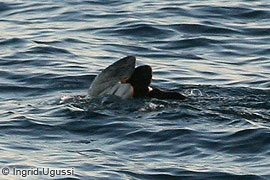 |
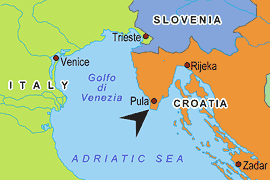 |
|
|
Seal sighting at Banjola, south of Pula. |
Sighting area. |
A newborn monk seal pup was the focus of a dramatic rescue on the Aegean island of Tinos on 1 October, in the midst of a force-9 gale.
The cries of the infant, echoing across the deserted waterfront of Kolimpithra beach on Tinos’ north coast, attracted the attention of Viktoria Drouga, the owner of a local taverna and boarding-house. Seeing the pup fighting the storm waves, Viktoria jumped into the sea herself to rescue the animal.
“We all owe Viktoria a debt of gratitude,” says Jeny Androukaki, head of MOm’s Monk Seal Rescue Centre. “She managed to grab the pup and carry it ashore, and then take all the right steps in an emergency like this – calling the Port Police and calling us.”
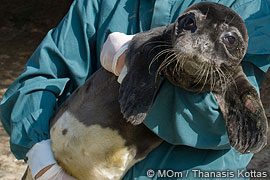 |
|
|
Rescue on Tinos. |
MOm, a Greek charity specialising in the study and protection of the Mediterranean monk seal, was then able to provide basic care instructions by telephone before dispatching their own rescue team to the island.
“Viktoria had already taken the first essential steps herself,” says Androukaki, “laying the pup on the dry sand of the beach to calm down and to dry in the sun, because it was shivering, very cold and very exhausted. We then asked her to keep watch over it, making sure that it wouldn’t be disturbed by people or animals.”
Based on previous cases in which monk seals have been orphaned, it is thought that storm waves may have washed the pup out of its cave shelter, separating it from its mother.
“During the next seven hours,” explains Androukaki, “the seal didn’t move at all, only slept. Then it started to bark, but didn’t make any attempt to re-enter the sea, which was still very rough. We had hoped that being there on the beach, the mother might appear and find her pup. When that proved increasingly unlikely, we asked Viktoria to place the pup inside a boat that was hauled up on the sand, so that it could be kept safe but would still be heard by its mother if she did appear.”
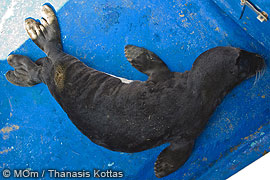 |
|
|
On the boat at Kolimpithra beach. |
There was still no sign of the mother, however, and as the storms continued to rage, MOm’s own rescue team remained stranded in Athens, with all sailings from Piraeus cancelled by order of Port Police authorities.
It was to be another 3 hours before the ban was lifted and the ferry could finally sail for Tinos.
“When we arrived, 24 hours after the alert, the pup was still inside the boat,” says Androukaki. “It was in rather good condition under the circumstances, but weak. It was also very small, the umbilical cord still attached when Viktoria first found it. Although it was no longer attached, the umbilicus was completely open. We therefore estimated its age at about 4 days when we first examined it then, on 2 October.”
The pup, a female, had sustained wounds after being dashed against the rocks, some superficial, some deeper and potentially more serious. The rescue team administered first aid, including oral rehydration salts, a standard treatment in stabilising the pup’s condition.
In consultation with their veterinarian, Prof. Anastasia Komninou of the Veterinary Faculty of Aristotle University, Thessalonica, it was decided that the pup would have to be transferred to the Monk Seal Rehabilitation Centre on Alonnisos, in the Northern Sporades Marine Park.
There was no other option for the pup than to undergo long-term rehabilitation. “At this young age the animals are still in lactation,” explains Androukaki, “and they are dependant on their mother’s milk until they are 3-4 months old.”
The rescue team returned with the pup to Athens – another 4-hour journey in stormy conditions.
Meanwhile, veterinarian Anastasia Komninou flew in from Thessalonica, ready to make a clinical examination of the patient that same night.
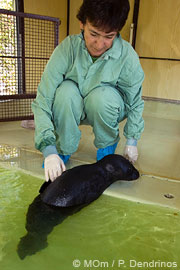 |
|
|
Jeny Androukaki supervises a swimming lesson. |
Blood, bacteriological and parasitological samples were all taken, the first laboratory results indicating low sugar and protein counts, due to lack of food, though no anaemia or parasite infestation. “Following a 24-period administering the rehydration salts,” says Androukaki, “we began treatment with fish porridge, using fatty fish like tuna, with the addition of glucose and salts. We administered antibiotics for the treatment of the wounds, but also preventively in case the umbilicus should become infected – such an infection could be lethal for a seal.”
A day after arriving in Athens, the rescue team headed for the Rehabilitation Centre at Steni Vala, Alonnisos, the pup quickly settling in despite the long journey and its fright on Tinos.
Staff described the pup as adapting well to her new surroundings, feeding well, sleeping peacefully when tired, and learning to swim.
“At this stage,” says Androukaki, “we feed the animal 6 times a day, every 4 hours, including a night feeding at 4 o’clock. The feedings alternate between fish porridge and oral rehydration therapy, so as to gradually acclimatise her to the food.”
In honour of her rescuer, the seal was given the name Viktoria.
Her prospects for survival – always touch and go in critical cases like these – are likely to become more apparent over the following weeks. – William Johnson.
Stop press…
Seal pup Viktoria has continued to make good and steady progress in her rehabilitation at Steni Vala, Alonnisos. As of 14 November when we went to press, she weighed in at 26 kg.
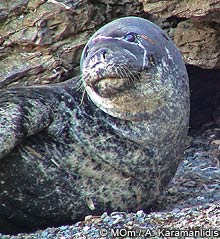 |
|
|
‘Aggelis’ |
It was one of the few occasions that MOm’s Rescue Team had conducted a monk seal necropsy only to find that the animal had died of old age – a possibly newsworthy event in itself given the high percentage of monk seal deaths that are human-induced. The other side of the story, however, was that this male seal, found dead in early June was ‘Aggelis’ – sad news for the local (fishing) community of Alonnisos.
Aggelis was well known amongst the ‘Alonissians’; for the past five years, they used to watch him swim into the main harbour of the island, with no fear of man and an obviously outgoing personality. The seal used to frequent the area, ‘stroll’ around the fishing boats, have his picture taken and even get a treat from the local fishermen. For the inhabitants of the island, Aggelis was not as rare a sight as Mediterranean monk seals usually are. He was actually part of their everyday life.
The body of Aggelis was found on 2 June near the island of Skopelos by a tourist, who immediately alerted MOm. MOm’s Rescue Team conducted the necropsy the very next day and Aggelis was identified by marks on his body as well as the distinctive patch that male monk seals have on their abdomen. At the necropsy no signs of a violent death were found. The examination of his teeth showed that he was of advanced age, while his stomach contained only a few remains of food, indicating that the animal hadn’t eaten for some time. – Calliope I. Lagonika, MOm.
While we all remember the joys of memorizing multiplication tables and passing notes in class, ‘seal school’, in MOm’s information centre in Patitiri, Alonnisos, is anything but your typical school. Through the use of books, games, videos, arts and crafts, and hands-on experiments, the programme seeks to educate children about the environment and to introduce critical themes in conservation. Furthermore, the programme endeavors to empower children with the skills they will need to become our planet’s future problem-solvers: creativity, team-work, and a hunger for knowledge.
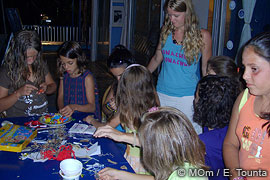 |
|
|
Seal School, Alonnisos. |
Seal school was launched in the summer of 2006 and has been expanding ever since. Daily children’s hour allows kids of all ages to participate in reading contests, create artworks, or increase computer skills. Through inspiration from MOm volunteers, special evening programmes ranging from yoga to song-writing to jewellery-making classes are also offered. The heart of the programme, however, consists of weekly classes that educate students about the environment around them. While themes range from forests to sea creatures, the focus of every lesson is to combine book-based learning with hands-on experiences: a lesson about insects challenges kids to collect and study live specimens, while a lesson about trash concludes with in-house paper recycling. Additionally, a new programme, ‘I Care’, called on students to perform a weekly service to the environment such as turning off lights in a vacant room, conserving paper, or doing one thing to be of service to someone else. A progress chart was maintained in the centre to record student actions.
The summer of 2007 proved very successful for the school. In addition to local children who frequented the centre, visitors to the island also took part in the activities. In total, 150 children participated in the summer lessons, hundreds of books were loaned from the centre’s children’s library, and an enjoyable and productive summer was had by both students and MOm volunteers.
The school will strive to continue to expand and to seek new and innovative ways to both strengthen kids’ understanding of the environment as well as to enrich the minds of tomorrow’s leaders. – Emily Joseph, MOm.
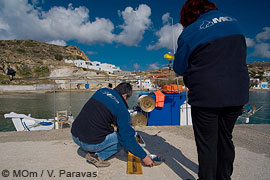 |
|
|
MOFI biologists fish sampling at Kimolos. |
The Greek island of Kimolos, along with its neighbour Polyaigos, is one of the most important habitats for the Mediterranean monk seal, hosting 43 adult individuals with an average reproduction rate of 8 pups per year. It also hosts a small but active fishing community that depends on coastal fisheries for its livelihoods. For these reasons, the area (which is also a Natura 2000 site) was selected as one of the two most important of 7 hot spots for MOm’s MOFI project on the interaction between the Mediterranean monk seal and fisheries in Greece.
Research activities on the island began in early March, with MOFI researchers being invited aboard local fishing boats and, in collaboration with the fishermen themselves, measuring the actual intensity of interactions between monk seals and fisheries.
During each expedition, sample fishing with trammel nets and gillnets is conducted for at least 5 consecutive days on active fishing boats. The sampling scheme involves one fishing boat available for multiple days and multiple expeditions, or multiple fishing boats. The parameters measured include catch per unit of effort, seasonal variation and variation by type of fishing gear along with damages from seals or other marine species.
Also yield data from local fishing boats during landings are recorded every month for a total of 24 consecutive months in each area. The data involve relative fish stock abundance and damages sustained from marine mammals. Parallel to this, a survey is conducted among as many fishermen as possible seeking information on damage attributable to marine animals. The survey also provides an excellent opportunity for the fishermen to make their own suggestions on how to resolve their ancient conflict with the seals. – Calliope I. Lagonika, MOm.
MOm’s short documentary ‘Monk Seals and Fishermen’ depicts the uneasy relationship between man and wildlife. The documentary reveals a true story behind the ‘sea-sun-sand’ stereotype that usually follows the Greek islands: a dying coastal fisheries sector and a protected marine mammal that is facing extinction partly due to its interaction with fisheries.
Through strong images and interviews with local fishermen filmed on site during the MOFI project’s activities, one gets to see what it means being a coastal fisherman in Greece. Facing financial problems that don’t seem to be getting any better, these fishermen also face the cost of damage that monk seals inflict on fishing gear while hunting for food. On the other hand, the documentary reveals how fisheries pose a serious threat to this critically endangered marine mammal.
The aim of the film is to sensitise the local and national public about the survival of local fishing communities and the monk seal. The documentary was already aired on the island of Zakynthos, where the first of a series of open public meetings was held. A clip of MOm’s documentary (in Greek) will soon be available at www.mofi.gr. – Calliope I. Lagonika, MOm.
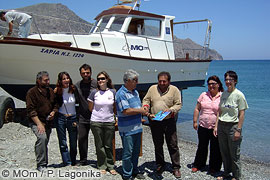 |
|
|
Handing over the patrol boat ‘Saria’ to the Karpathos-Saria protected area management body. |
In order to further support the operation of the Karpathos-Saria protected area, MOm has provided its speed boat ‘SARIA’ to the PA’s Management Body, as well as the exhibition items of its Information Centre.
MOm has been contributing towards the protection of this NATURA 2000 site since 1997. The monitoring of the local monk seal population, the operation of the Information Centre and the implementation of a pilot guarding project, are among some of MOm’s activities in the area. Since 2006, MOm has also served as a member of the Management Body. – Stella Adamantopoulou, MOm.
The morning of the 13th of September was horribly windy in the north of Karpathos. The streets of Diafani, the only harbour of the area, were deserted – but not for long. Two school buses soon arrived at the dock and children of all ages along with parents, grandparents, aunts and uncles disembarked, eager to set foot on one of the most unusual boats they had ever seen: IFAW’s research vessel ‘Song of the Whale’.
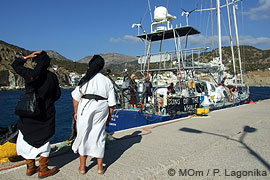 |
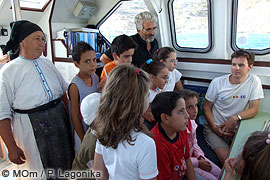 |
|
|
Object of curiosity at Diafani. |
Aboard the ‘Song of the Whale’. |
This 21 metre-long sailing boat, specially adapted for cetacean research, had already embarked on its Mediterranean travels months earlier. The Karpathos expedition was planned by IFAW, MOm and the protected area’s Management Body. IFAW has supported a number of MOm monk seal conservation programmes since 1990.
The researchers on the ‘Song of the Whale’ study whales, dolphins and porpoises by recording them through hydrophones, take photographs of the animals, monitor cetacean populations across the world and even respond to incidents of animals entangled in fishing gear. All this and more was presented to the locals of Diafani, the researchers fielding their questions and relating stories about encounters with cetaceans. Lesley O’Donnell, Director of IFAW’s European Union Office, who joined the expedition said, “we were surprised by the high turn-out, especially with such bad weather.”
The ‘Song of the Whale’ left Karpathos Island a couple of days later to continue its journeys around the world. – Calliope I. Lagonika, MOm.
With the monk seal pupping season gradually reaching its peak in Greek waters, MOm researchers are currently reporting that 26 pups have already been born in various cave shelters – a number that is expected to grow in the weeks to come.
New research data from visits to pupping sites in the Aegean Sea estimate the number of newborn monk seals to be 16. Seven pups have been recorded in the Kimolos – Polyaigos island complex (of which 1 was unfortunately found dead), while 8 were found in the wider area of the central Aegean. One of these, encountered at Tinos island, was found orphaned and was subsequently transferred to the monk seal rehabilitation centre in Steni Vala on Alonnisos. One more pup was recorded in Argolis on the Peloponnese, but the cave shelter where it was born was heavily exposed to bad weather, resulting in the loss of the pup.
Local reporters from the Rescue and Information Network (RINT) have recorded 10 additional pups at other Greek mainland coasts and islands. After many years, 2 pups were sighted near the city of Kavala, in the Northern Aegean. The remainder of the newborns were sighted at the islands of Milos (2), Naxos (1), Karpathos (1), Zakynthos (1), Evia (2) and Kithira (1). However, the latter sightings in Evia and Kithira islands concern dead animals. – Vangelis Paravas, Mom.
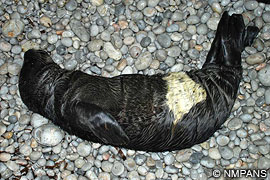 |
|
|
|
Monitoring activities throughout the wider Marine Park Area have been carried out by the scientific team of the NMPANS Management Body, mainly to assess the status of the monk seal habitats and population.
Since the middle of August the scientists of the Park have conducted several surveys of the Park’s monk seal shelters by visiting the monk seal sites in order to record the condition of the shelters, signs of occupation (tracks, sleeping hollows, smell, scats and fur) or presence of monk seals. A database and special forms to record data have been also designed.
Surveys showed a degradation of the monk seal shelters due to structural morphological changes caused by wind and wave action. Despite the decrease of suitable monk seal breeding sites, the results regarding the breeding season of 2007 are very encouraging.
The first two pups were observed during the first week of October and a week later three more newborn pups were recorded in the shelters of the Marine Park. Until now the pups are in excellent health, nursed and looked after by their mothers.
The rangers and the scientific team of the NMPANS are patrolling the area of the Marine Park, checking on human activities and monitoring the condition of the pups, offering the safest possible environment for the survival of the newborn seals during the first critical weeks of their life.
Until the beginning of November 2007, five newborn pups, one juvenile, and four adult monk seals were observed in the wider area of the NMPANS. – Management Body of the National Marine Park of Alonnisos Northern Sporades.
Deadly puffer fish seen in Greek waters
Rising temperatures in the Mediterranean Sea have created appropriate conditions for the migration of a puffer fish from the Red Sea that can be lethal to humans, authorities said yesterday. According to researchers, the Lagocephalus sceleratus carries potentially deadly toxins in its liver, skin and reproductive organs which are capable of causing muscle paralysis, breathing and blood circulation problems if consumed.
“Our health inspection office has alerted all associations of fishermen and fish merchants,” the Athens prefecture said in a statement. The grey fish, which has a beak-shaped mouth and four large teeth, has been sighted in waters off the Dodecanese islands of Rhodes and Symi as well as off Crete. (Kathemerini English Edition, 5 June 2007)
http://www.ekathimerini.com/4dcgi/_w_articles_politics_100022_05/06/2007_84126
Tourists take action
Tourists aren't turning a blind eye to animal suffering. Protests from visitors concerning the abuse of animals are so common that the ministry of tourism standard complaints form has ‘Animals, maltreatment’ listed among other such popular grievances as unscrupulous taxi drivers and overpriced restaurants. (Athens News, 3 August 2007)
http://www.athensnews.gr/athweb/nathens.prnt_article?e=C&f=13246&t=01&m=A07&aa=1
The two young seals that are making Alonnisos “go nuts”!
According to the Chairman of the Management Board of the NMPANS [National Marine Park of Alonnisos, Northern Sporades] and Professor of Ichthyology at the University of Thessaly’s Department of Marine Environment - Ichthyology Christos Neofytou: “Officials of our Board were visiting the caves in Piperi since the beginning of the summer and had seen no trails of seals. We were concerned, as we thought that the seals were not visiting any more the caves in the specific area. Nevertheless, members of our Board continued to visit these caves for various observations and eventually, last Sunday we had the good news, as two young seals were sighted in different caves.” […]
There are 17 caves in Piperi that constitute seal refuges, while caves also exist in other parts of the islands, such as Gioura.
As Mr. Neofytou underlined, “this development with the first seal births is very encouraging. Seal births usually take place in the October-November period. Every year around 7-8 seals are born and manage to survive. Of course, a larger number of seals are born, but they don’t manage to survive, either because they are eaten by other animals or because they are abandoned by their mothers.” (Espresso, 17 October 2007)
http://www.espressonews.gr/default.asp?pid=21&la=1&catid=1&artid=470887
A fishy situation
Seaside tavernas are overflowing with tourists and locals craving the culinary delights of traditional Greek cuisine, but few are likely aware of a growing problem that threatens to eclipse the delights of their zesty seafood appetiser: overfishing.
The routine overfishing of various stocks of fish, and the resulting practice of catching and selling fish that are smaller than the minimum size limit enforced by the ministry of agriculture, says Greenpeace Greece ocean campaigner Sophia Tsenikli, is a major issue in Greece.
“Unfortunately, there are still no adequate controls in place for the protection of undersized fish,” she says. “Therefore, small fish are still sold in Greek markets and restaurants, especially in areas with high levels of tourism and, therefore, high demand for fish.” […]
Tsenikli asserts that laws mandating the size and quantity of fish that may be caught and sold are largely being evaded throughout the country, as well as across the EU. […]
Greenpeace has taken active measures in campaigning for the enforcement of regulatory laws. GP Greece, for example, launched the Size Matters project in the summer of 2005. Its investigation of Greece's main landing sites revealed that enormous amounts of undersized fish were regularly being sold free of any restrictions or controls.
As a result, the ministry of agriculture sent an official reply to Greenpeace, promising to create a control mechanism for fisheries products. However, in 2006, GP Greece conducted follow-up investigations at the main fish markets in Athens and Piraeus, and discovered that nothing has changed – small fish are still being caught and sold in large amounts. […] (Athens News, 17 August 2007)
http://www.athensnews.gr/athweb/nathens.prnt_article?e=C&f=13248&t=01&m=A11&aa=1
EndQuoteResidents on the island of Alonnissos, in the Sporades, have asked authorities to curb the alleged expansionist activities of a monastery on the nearby islet of Kyra Panayia, which, they say, are a threat to local archaeological sites and the national park of which the islands form a part. According to local environmental groups and residents, monks have already built roads on the islet and are seeking a license to build five desalination units. Furthermore, the monastery keeper is alleged to have increased his flock of sheep and goats from 300 to 4,400 in order to apply for EU subsidies to fund the planned construction. The monastery has reportedly been cautioned by local authorities, and a Volos magistrate has launched a probe into its alleged activities. But the monks have appealed to the Central Archaeological Council for leave to press ahead with construction plans.
|
Mediterranean News continues with Madeira, Mauritania & Western Sahara, Morocco and Turkey...
Copyright © 2007 The Monachus Guardian. All Rights Reserved |